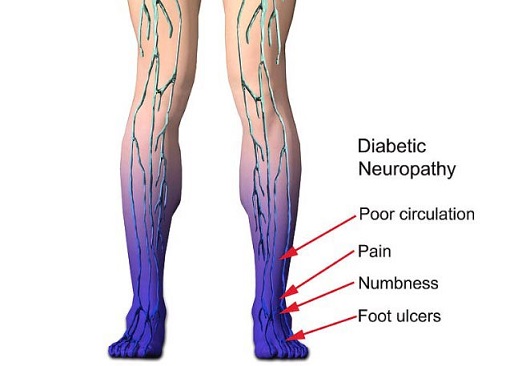Nikhil Prasad Fact checked by:Thailand Medical News Jul 26, 2024 9 months, 10 hours, 2 minutes ago
Diabetes News: Researchers from the State University of Ceará, Brazil, have discovered that anethole, a natural compound found in many plants, can prevent nerve damage caused by diabetes. This
Diabetes News report delves into their findings.
 Brazilian study shows that Anethole can prevent diabetes-induced nerve damage
Understanding Diabetic Neuropathy
Brazilian study shows that Anethole can prevent diabetes-induced nerve damage
Understanding Diabetic Neuropathy
Diabetes mellitus (DM) is a chronic condition that affects millions worldwide. One of the severe complications of diabetes is diabetic peripheral neuropathy (DPN), which can lead to debilitating pain and, in severe cases, limb amputation. The sciatic nerve, which runs from the lower back down to the legs, is often studied in relation to DPN because it innervates the lower limbs and is prone to damage from high blood sugar levels.
The Role of Anethole
Anethole is a terpenoid commonly found in plants like anise, fennel, and star anise. It is known for its antioxidant, anti-inflammatory, and neuroprotective properties. Researchers have explored anethole’s potential to counteract the damaging effects of diabetes on nerves.
Study Design and Methods
The study involved four groups of rats: a control group, a control group treated with anethole, a diabetic group, and a diabetic group treated with anethole. Diabetes was induced in the rats using streptozotocin (STZ), a chemical that mimics the effects of diabetes by destroying insulin-producing cells in the pancreas.
After confirming the development of diabetes, researchers treated the diabetic rats with anethole for four weeks. They measured various parameters, including blood sugar levels, body weight, water intake, food consumption, and urinary output. They also examined the sciatic nerve for morphological, electrophysiological, and biochemical changes.
Key Findings
-Glycemic Control and Body Mass
Despite being diabetic, rats treated with anethole showed a slight reduction in blood sugar levels compared to untreated diabetic rats. While the blood sugar levels were still higher than the control group, this slight reduction indicates anethole’s potential in managing diabetes. Furthermore, the treated diabetic rats did not experience the same significant weight loss observed in untreated diabetic rats.
-Mechanical Sensitivity
Diabetic rats typically develop increased sensitivity to pain due to nerve damage. In this study, diabetic rats showed heightened pain sensitivity, which anethole treatment partially alleviated. This suggests that anethole can help mitigate some of the painful symptoms associated with diabetic neuropathy.
-Nerve Morphology
One of the most striking findings was that anethole prevented the reduction in the cross-sectional area of the sciatic nerve in diabetic rats. Diabetic rats typically showed a significant decrease in nerve size due to axonal degeneration and red
uced numbers of nerve fibers. However, those treated with anethole maintained a nerve size comparable to non-diabetic rats. This indicates that anethole helps preserve nerve structure and function.
-Electrophysiological Properties
Electrophysiological measurements showed that diabetes reduced the conduction velocity of nerve signals and altered the nerve’s electrical properties. Anethole treatment prevented these changes, maintaining normal nerve conduction velocities and signal durations. This finding is crucial because it demonstrates anethole’s ability to preserve nerve function in diabetic conditions.
-Oxidative Stress Markers
Diabetes increases oxidative stress, leading to further nerve damage. The study found that diabetic rats had higher levels of oxidative stress markers, such as thiobarbituric acid reactive substances (TBARS) and lower levels of protective antioxidants like thiols. Anethole treatment normalized these levels, suggesting its role in combating oxidative stress in diabetic neuropathy.
 Diabetic Neuropathy
Implications and Future Research
Diabetic Neuropathy
Implications and Future Research
The study's findings are promising, indicating that anethole has significant potential as a therapeutic agent for diabetic neuropathy. Its ability to prevent structural and functional nerve damage, reduce oxidative stress, and manage blood sugar levels positions it as a valuable compound in diabetes treatment.
While the study was conducted on rats, the implications for human health are significant. Anethole is a natural compound with low toxicity, already used in the food and cosmetic industries, making it a feasible candidate for pharmaceutical development.
Conclusion
Anethole shows great promise in preventing and treating diabetic neuropathy. Its protective effects on nerve structure and function, combined with its antioxidant properties, make it a potential therapeutic agent for managing diabetes complications. Further research is needed to explore its efficacy in humans, but the findings are a significant step forward in the search for effective treatments for diabetic neuropathy.
The study findings were published in the peer-reviewed International Journal of Molecular Sciences.
https://www.mdpi.com/1422-0067/25/15/8133
For the latest
Diabetes News, keep on logging to Thailand Medical News.
Read Also:
https://www.thailandmedical.news/news/thailand-medical-researchers-discover-phytochemicals-from-orchid-roots-that-can-be-used-to-fight-diabetes
https://www.thailandmedical.news/news/the-role-of-microrna-in-diabetic-retinopathy

